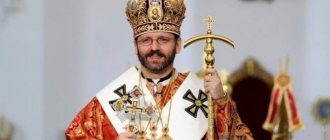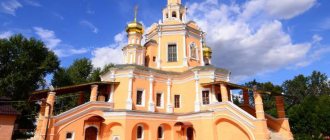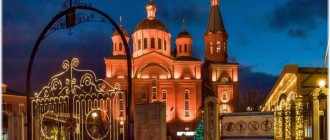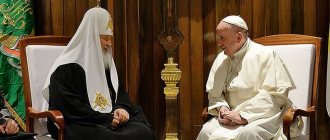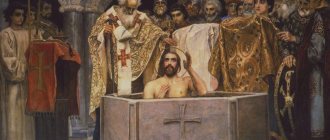Monophysite churches on the website of Igor Garshin.
Ancient Eastern churches Home
| Write |
Home > Esoterics > Religions > Christianity > Ancient Eastern churches
Alphabetical list of pages: | | | | | E (Yo) | | | | | | | | | | | | | | | | | | | | | | | | 0-9 | AZ (English)
Ancient Eastern Churches - a group of ancient churches of Eastern Christianity that recognize the decrees and profess the doctrinal dogmas of only the first 2 or 3 Ecumenical Councils
.
These include the Dyophysite Assyrian
and 6 Monophysite churches (
Armenian
,
Coptic
,
Malankara
,
Syrian
,
Eritrean
,
Ethiopian
).
The last 6 Eastern churches are called "Oriental Orthodox" or "Ancient Orthodox" churches. They do not recognize Chalcedon and all subsequent Ecumenical Councils
, in connection with which they are also called
Miaphysite
and
non-Chalcedonian
churches.
The Dyophysite Assyrian Church of the East recognizes even less - only the first two Ecumenical Councils.
Sections of the page about ancient Eastern churches:
- Dyophysite, Monophysite and Miaphysite Christologies
- Assyrian Church of the East
- Armenian Apostolic Church
- Coptic Orthodox Church
- Malankara Orthodox Church
- Syro-Jacobite Orthodox Church
- Malankara Orthodox Church (St. Thomas Christians)
- Eritrean Orthodox Church
- Ethiopian Orthodox Church
Dyophysite, Monophysite and Miaphysite Christologies
Diaphysitism
The Assyrian Church of the East does not belong to the Miaphysite non-Cholcedonian Churches, which are the Armenian, Coptic and other churches. The Assyrians profess the Nestorian interpretation of Christianity. They recognize only the first 2 Ecumenical Councils, the Miaphysites - 3, and the Orthodox and Catholics - all 7. The Nestorians do not recognize the Virgin Mary as the Mother of God. For them, she is an ordinary woman who gave birth to a boy, who later became God.
Miaphysitism
Miaphysitism (from ancient Greek μία - “single” + φύσις - “nature, nature”) is a Christological doctrine of the ancient Eastern churches, affirming the unity of the Theanthropic nature of Jesus Christ. Arose in the 5th century as a result of the theological polemics of St. Cyril of Alexandria from the Alexandrian theological school against Nestorius of Constantinople
, according to Antiochian theology, who preached natural division in Christ.
The term “miaphysitism” by those professing this doctrine is derived from that attributed to Athanasius the Great
formulas “μία φύσις τοῦ θεοῦ λόγου σεσαρκωμένη.”
Using this formula, St.
Cyril refuted
the diophysitism of Nestorius
(two natures, two hypostases, one person), arguing that in order to confess the One Person of the incarnate Son of God, the two perfect natures of God and man must be in unity (ancient Greek “μία φύσις”) and form a single hypostasis .
Unlike the Monophysite
Eutyches
heresy ,
miaphysitism
does not teach about the mixing of two natures in Christ or the absorption of one into the other, but speaks only about their indissoluble unity with the complete preservation of their properties, which is emphasized in one of his works by the famous miaphysite theologian Pope of Alexandria (Coptic Orthodox Church) Shenouda III.
(Wikipedia)
Differences between Eastern and Western Christianity[ | ]
Main article: Differences between Orthodoxy and Catholicism
The main dogmatic differences between the Orthodox and the Latins, who are usually called by their self-name Catholics (which does not correspond to the essentially correct name from the Orthodox point of view), are
- the difference in the Creed is about the origin of the Holy Spirit (Filioque)[5].
- belief in the infallibility of the Pope in matters of faith and morals (ex cathedra), considering the pope to be the vicar of Christ on earth. Catholics consider the source of their doctrine not only the Bible, but also the decisions of all councils, which they call Ecumenical (and not just the first seven, recognized by the Orthodox) and the judgments of the popes, which for them even have priority over the judgment of the councils.
There are other discrepancies in dogma, going back to the fact that the Latins accepted new dogmas (or dogmatized some opinions that existed earlier), from the point of view of the Orthodox, arbitrarily and arbitrarily, without a conciliar discussion with the Orthodox (the fullness of the Church), considering their own , without the participation of the Orthodox, councils are for Ecumenical and therefore sufficient. Such dogmas, for example, include the Latin belief in purgatory (in addition to heaven and hell).
The clergy in Catholicism takes a mandatory vow of celibacy. There are also numerous differences in sacraments and rituals[5]. One of the important differences in the past, even before the division, was the significant difference in the communion of clergy and laity in the Roman tradition.
In addition, a distinction can be made between the Eastern and Western models of the church on the basis of their relationship to secular authority. If the church institutions of the Western branch operated during the Middle Ages according to the idea of the “two swords” of power, which God transfers into the hands of the church, which, in turn, provides one of them to the king, which means their equal existence and creates the preconditions for the church’s struggle for supremacy in government, then in the Eastern model the church distances itself from politics, recognizes the secular power of the emperor and retains its influence only in the spiritual, clerical aspect.[6]
Assyrian (Syro-Persian) Church of the East [Dyophysite = Nestorian]
| The Syro-Persian Church belongs to Nestorian Church . Formed in 484 on the basis of the Persian (“Chaldean”) Church and the Patriarchate of “Seleucia-Ctesiphon” (modern Baghdad). It spread throughout Arabia, Northern India and Central Asia (up to and including China) among the Turkic and Mongolian peoples. In the VII-XI centuries. - the largest Christian Church in terms of territory. In the XIV century. almost completely destroyed by Tamerlane. In 1898, several thousand Isors (Assyrian Christians) from Turkey, led by Arch. Mar Jonah of Urmia transferred to the Russian Orthodox Church [and the rest?]. Assyrian Church of the East (or simply Church of the East ) is the only ancient Eastern Church currently existing that rejects not only |
Eastern Christianity
Further information: History of Eastern Christianity.
Comparative distribution of Eastern Orthodoxy and Oriental Orthodoxy in the world by country
| Eastern Orthodoxy  Dominant religion (more than 75%)  Dominant religion (50–75%)  Important minority religion (20–50%)  Important minority religion (5–20%)  Minority religion (1–5%) | Eastern Orthodoxy  Dominant religion (more than 75%)  Dominant religion (50–75%)  Important minority religion (20–50%)  Important minority religion (5–20%)  Minority religion (1–5%) |
Eastern Christians do not share the same religious traditions, but do share many cultural traditions. Christianity became divided in the East in its early centuries, both within and outside the Roman Empire, in disputes over Christology and fundamental theology, as well as national divisions (Roman, Persian, etc. It would be many centuries later when Western Christianity was fully separate from these traditions as its own communion.The major branches or families of Eastern Christianity, each with its own theology and dogma, include the Eastern Orthodox Church, the Oriental Orthodox Community, the Eastern Catholic Churches, and the Assyrian Church of the East.[5]
In many Eastern churches, some parish priests administer the sacrament of confirmation to infants after baptism, and priests may marry before consent. While all Eastern Catholic churches recognize the authority of the Pope, some of them, which were originally part of the Orthodox Church or Eastern Orthodox churches, strictly follow the traditions of Orthodoxy or Eastern Orthodoxy, including the tradition of allowing married men to become priests.
The differences between the Eastern churches and Western Christianity are related not only to theology, but also to culture, language and politics. For non-Catholic Eastern churches, a definitive date for the start of the schism cannot usually be given (see East-West Schism). The Church of the East declared independence from the churches of the Roman Empire at its general council in 424, which preceded the Council of Ephesus in 431, and therefore had nothing in common with the theology proclaimed at that council. Eastern Orthodoxy separated after the Council of Chalcedon in 451.
Since the time of the historian Edward Gibbon, the schism between the Roman and Orthodox churches has been conveniently dated to 1054, although in reality things are more complicated. This schism is sometimes called the Great Schism
, but is now more commonly referred to as the East–West schism. This final split reflected the larger cultural and political division that developed in Europe and Southwest Asia during the Middle Ages and coincided with the rebirth of Western Europe after the collapse of the Western Roman Empire.
The Ukrainian Lutheran Church emerged in Galicia around 1926, its rites based on the liturgy of St. John Chrysostom, rather than the Western Missae formula
. [6] [7]
Eastern Orthodox ChurchEdit
Further information: History of the Eastern Orthodox Church.
Christ Pantocrator, detail of the Deesis mosaic in the Hagia Sophia - Constantinople (Istanbul) XII century.
The Eastern Orthodox Church is a Christian organization whose adherents are mainly found in Western Asia (especially Syria, Lebanon, Jordan, Israel and Palestine) and Turkey, Eastern Europe, the Balkans and the Caucasus (Georgia, Abkhazia, Ossetia, etc.). D.). with a growing presence in the Western world. Eastern Orthodox Christians accept the decisions of the first seven Ecumenical Councils.
Eastern Orthodox Christianity identifies itself as the original Christian church (see Early Centers of Christianity) founded by Christ and the Apostles, and traces its lineage to the early church through a process of apostolic succession and unchanging theology and practice. Distinctive features of the Eastern Orthodox Church include the Byzantine rite (shared with some Eastern Catholic churches) and an emphasis on the continuation of Sacred Tradition, which it considers apostolic in nature.
The Eastern Orthodox Church is composed of self-governing jurisdictions based on geography, nationality, ethnicity or language. Thus, Eastern Orthodoxy consists of fourteen or sixteen autocephalous bodies. The smaller churches are autonomous and each has a mother church, which is autocephalous.
All Eastern Orthodox Christians are united in doctrinal agreement with each other, although some are currently out of fellowship for non-doctrinal reasons. This is in contrast to the Catholic Church and its various churches. The members of the latter are all in communication with each other, part of a hierarchy from top to bottom (see Primus inter pares
).
Eastern Orthodox Christians reject the Filioque Clause as heresy, in sharp contrast to most Catholics. However, some Catholics who are not in communion with the Catholic Church side with the Orthodox here and reject this teaching, putting them in theological disagreement with the rest.
It can also be noted that the Roman Church was once in communion with the Eastern Orthodox Church, but after the schism between East and West they separated and thus it is no longer in communion with the Eastern Orthodox Church.
There are an estimated 240 million Eastern Orthodox Christians in the world. [note 2] Today, many adherents avoid the term "Eastern" as denying the universal character of the church. They call Eastern Orthodoxy simply the Orthodox Church
. [8]
Eastern OrthodoxyEdit
Main article: Eastern Orthodox Churches
Eastern Orthodoxy refers to the churches of the Eastern Christian tradition that hold the faith of the first three Ecumenical Councils in the undivided Christian Church: the First Council of Nicea (AD 325), the First Council of Constantinople (381) and the Council of Ephesus (431), rejecting the dogmatic definitions of Chalcedon ( 451). Hence, these churches are also called ancient Eastern churches
. They include the Coptic Orthodox Church, Malankara Orthodox Church (India), Eritrean Tewahedo Orthodox Church, Ethiopian Tewahedo Orthodox Church, Syriac Orthodox Church and the Armenian Apostolic Church.
Eastern Orthodoxy arose as a reaction to Chalcedon on the eastern border of the Byzantine Empire, as well as in Egypt, Syria and Mesopotamia. There are also Orthodox patriarchs in these places, but the rivalry between them has largely disappeared in the centuries since the schism.
Church of the EastEdit
Main articles: Church of the East, Nestorianism, and Lakhmids
Historically, the Church of the East was the broadest-reaching branch of Eastern Christianity, at its height spreading from its hinterland in Persian-ruled Assyria to the Mediterranean, India and China. Initially the only Christian church recognized by Zoroastrian-led Sasanian Persia (through its alliance with the Lakhmids, regional rivals of the Byzantines and its Ghassanid vassal), the Church of the East declared itself independent of the other churches in 424 and over the next century adhered to Nestorianism, the Christological doctrine put forward by Nestorius , Patriarch of Constantinople from 428 to 431, who was declared heretical by the Roman Empire. After this, in the West it was often called the Nestorian Church, perhaps inaccurately. After surviving a period of persecution in Persia, the Church of the East flourished under the Abbasid Caliphate and branched out, creating dioceses throughout Asia. After another period of expansion under the Mongol Empire, the church declined starting in the 14th century and was eventually largely confined to the central region of its Assyrian founders in the Assyrian homeland, although another remnant survives on the Malabar Coast of India.
In the 16th century, dynastic struggles led to a schism in the church, creating two competing churches: the Chaldean Catholic Church, which entered into communion with Rome as the Eastern Catholic Church, and the Assyrian Church of the East. The followers of these two churches are almost exclusively ethnic Assyrians. In India, the local church of the eastern community, known as the St. Thomas Christians, experienced its own divisions as a result of Portuguese influence.
Assyrian Church of the EastEdit
Main articles: Church of the East and Assyrian Church of the East
The Assyrian Church of the East arose from the historical Church of the East, which was located in Mesopotamia/Assyria, then part of the Persian Empire, and spread widely throughout Asia. The modern Assyrian Church of the East arose in the 16th century after a schism with the Chaldean Church, which later entered into communion with Rome as the Eastern Catholic Church.
The Church of the East was associated with the doctrine of Nestorianism put forward by Nestorius, Patriarch of Constantinople from 428 to 431, which emphasized the separateness of the human and divine natures of Jesus. Nestorius and his teachings were condemned at the Council of Ephesus in 431, leading to the Nestorian Schism, in which churches supporting Nestorius separated from the rest of Christianity.
Many followers moved to Persia and joined the local Christian community. This community adopted an increasingly Nestorian theology and was often called the Nestorian Church from then on. Thus, the Church of the East accepts only the first two Ecumenical Councils of the undivided Church—the First Council of Nicea and the First Council of Constantinople—as defining its faith tradition and quickly took a different course from other Eastern Christians. .
The Church of the East spread widely through Persia and Asia, being introduced to India in the 6th century and to the Mongols and China in the 7th century. It underwent periodic expansion until the 14th century, when the church was almost destroyed by the collapse of the Mongol Empire and the conquests of Timur. By the 16th century, it was largely limited to Iraq, northeastern Syria, southeastern Turkey, northwestern Iran, and the Malabar coast of India (Kerala). The schism of the 15th century, when separate Assyrian and Chaldean churches emerged, left only the former as an independent sect. Additional schisms in the 20th century further impacted the history of the Assyrian Church of the East.
Saint Thomas ChristiansEdit
Main article: Saint Thomas Christians
The St. Thomas Christians are an ancient body of Christians on the southwest coast of India who trace their origins to the evangelistic activities of the Apostle Thomas in the 1st century. [9] By the 5th century, the Saint Thomas Christians were part of the Church of the East, or Nestorian Church. Until the mid-17th century and before the arrival of the Portuguese, the Christians of Thomas were united in faith and ritual. After this, differences arose between them, and hence today they consist of several different rites.
Eastern Catholic ChurchesEdit
Main article: Eastern Catholic Churches
The Eastern Catholic bishop of the Syro-Malabar Church holding the Mar THOMA cross, which symbolizes the heritage and identity of St. Thomas Christians in India
Twenty-three Eastern Catholic churches are in communion with the Holy See at the Vatican, while they are rooted in the theological and liturgical traditions of Eastern Christianity. Most of these churches were originally part of the Orthodox East, but have since been reconciled with the Roman Church.
Many of these churches originally belonged to one of the above families and are therefore closely related to them in spirit and liturgical practice. As in other Eastern churches, married men can become priests, and parish priests administer the secret of confirmation for newborns immediately after baptism, through the rite of confirmation; the infants are then given Holy Communion.
The Syro-Malabar Church, which is part of the St. Thomas Christian community in India, follows East Syrian traditions and liturgy. Other St. Thomas Christians in India who originally belonged to the same East Syriac tradition have instead moved to the West Syriac tradition and now form part of Eastern Orthodoxy (some of the Eastern Orthodox in India united with the Catholic Church in 1930 and became Syriacs. -Malankara Catholic Church). The Maronite Church claims to have never been separated from Rome, and has no counterpart to the Orthodox Church outside of communion with the Pope. Therefore, calling it a “Uniate” church is incorrect. The Italo-Albanian Catholic Church has also never been out of communion with Rome, but, unlike the Maronite Church, it resembles the liturgical rite of the Orthodox Church.
Dissenting movementsEdit
The Church of the Holy Cross is located in Kremenets and is part of the Ukrainian Lutheran Church, which uses the Byzantine rite.
In addition to these four main branches, there are a number of much smaller groups that arose out of disputes with the dominant traditions in their original areas. Most are either part of the more traditional Old Believers movement, which emerged from a schism within Russian Orthodoxy, or the more radical Spiritual Christianity movement. The latter includes a range of diverse "low-church" groups, from the Bible-focused Molokans to the anarchic Doukhobors and self-mutilating Skoptsy. None of these groups are in communion with the main churches listed above, with the exception of a few Old Believer parishes in communion with the Russian Orthodox Church Abroad. There are also national dissidents whose ethnic groups want their own national church, such as the Macedonian Orthodox Church and the Montenegrin Orthodox Church; both are domiciles of the Serbian Orthodox Church. There are also several Reformed churches that share features of Eastern Christianity to varying degrees.
"True Orthodox" churchesEdit
Main article: True Orthodoxy
Beginning in the 1920s, parallel hierarchies formed in opposition to local Orthodox churches on ecumenism and other issues. These jurisdictions sometimes call themselves "true Orthodox". In Russia, underground churches formed and maintained solidarity with the Russian Church Abroad until the late 1970s. Now there are traditionalist Orthodox Christians in all regions, although in Asia and Egypt their presence is negligible.
Eastern Protestant ChurchesEdit
Main article: Eastern Protestant Christianity
Protestant Eastern Christianity includes a collection of heterogeneous Protestant denominations that are largely the result of Protestant churches adopting Reformed versions of Orthodox Christian liturgy and worship. [10] [11] Some others are the result of a reformation from Orthodox beliefs and practices, inspired by the teachings of Western Protestant missionaries. [12] This category includes the Ukrainian Lutheran Church, St. Thomas Evangelical Church of India, Eastern Believers Church, Evangelical Orthodox Church, etc.
Byzantine Rite of LutheranismEdit
Main article: Byzantine Rite of Lutheranism
Byzantine Rite Lutheranism arose in the Ukrainian Lutheran Church around 1926. [2] It originated in the region of Galicia and its rites are based on the liturgy of St. John Chrysostom. [6] [7] The Church was persecuted under the communist regime, which pursued a policy of state atheism. [13]
Armenian Apostolic Church
The Armenian Church worships Jesus Christ, the Son of God, incarnate from two natures, Divine and human, and the Savior of the world”...His Body, one with God, could not see corruption.
Armenian Apostolic Church
is part of the Ancient Eastern Churches.
According to legend, it goes back to the apostles Thaddeus
and
Bartholomew
.
Historically formed in the 320s, through the works of St. Gregory the Illuminator (d. 335), whose son and successor, Aristakes, was a participant in the First Ecumenical Council. In its dogmatics it is based on the decisions of the first three Ecumenical Councils and adheres to the Christology of St. Cyril of Alexandria
(so-called miaphysitism [
monophysitism
?]).
Has seven sacraments, honors the Mother of God, icons, etc. in the IV Ecumenical Council
for objective reasons and did not recognize its resolutions (distorted by translation). In the period from 491 to 536 it finally separated from the unity of the Universal Church. Currently it has dioceses within Armenia and several others in America, Asia, Europe and Australia.
Christianity appeared in Armenia very early, and although the information left by Abgar is very unclear, nevertheless, the first reliable news comes from the 2nd century [!]. Christianity, heavily persecuted, sometimes completely disappeared there, until finally Bishop Gregory the Illuminator
Tiridates
in 301 and in the 5th century
Mesrop
did not translate the Bible into Armenian.
From that time on, activity began in the Armenian church, and Armenians began to frequently attend schools in Athens and Constantinople. In church disputes about the two natures of Christ, the Armenians sided with the Monophysites
with the approval of the Persian king Chosroes, who conquered the country in 536, they rejected
the formula
of the Council of Chalcedon
the Synod of Turin and since then separated into a special church, which they called honor of Gregory -
Gregorian
.
The head of their church became the Catholicos
(i.e., the universal bishop), living in
Etchmiadzin
, a monastery near Erivan, the ancient capital of Armenia.
Soon a rich scientific activity began among the Armenians, and significant theological literature preserved in Syriac began to be translated into Armenian in order to make it accessible to the Armenian clergy. Nerses-Klayetsi
, a 12th-century Armenian Catholicos whose works were published many times, is considered by Armenians their greatest theologian.
With the Greek (Orthodox) Church the Gregorians
still haven't merged. But the popes tried many times, for example, in 1145, 1341, 1440, when the Armenians turned to Western states for help against the Mohammedans, to tear the Armenians away from the old faith. The popes, however, only succeeded in creating a schism in the Armenian church.
Information on Armenian literature can be found on the Armenian language page.
- Armenian Apostolic Church. Review by P.I. Puchkova.
- Armenian Church. Brockhaus and Efron. Encyclopedic Dictionary. St. Petersburg, 1880.
- Armenian Apostolic Church - New Nakhichevan and Russian Diocese.
- Armenian Apostolic Church. On the website of the Union of Armenians of Russia.
- Reflections on the historical development of the Christological doctrine of the Armenian Church. Dvorkin A.L. [sensibly and with examples!]
Term[ | ]
The name is due to the fact that these directions of Christianity, preserving their ancient liturgical rites and traditions, historically arose in the territory of the Eastern Roman Empire, in Eastern Europe or in the Near and Middle East (Church of the East, Armenian Apostolic Church, Georgian Orthodox Church).
As a rule, representatives of these denominations themselves do not call themselves “Eastern Christians”. This term is more commonly used among adherents of Western Christianity, as well as religious scholars and specialists who study the history of Christianity. In their official documents, the Western and Eastern churches call themselves ecumenical[1].
Coptic Orthodox Church
The Coptic Church was founded by Saint Mark the Evangelist
, who arrived in Africa in 47-48. and preached in Alexandria, then the capital of Egypt. In 69 he was martyred by the Romans. Saint Mark is revered by the Copts as their first patriarch. From the very beginning, the Coptic Patriarch of Alexandria bore the title of pope, which was then given to the Roman bishop. The Coptic pope-patriarch is elected for life, enjoys unquestioned authority and is the leader of the nation. The current Pope, Shenouda III, was elected in 1971 and is a wonderful theologian and approachable person.
Christianity spread without much difficulty in ancient Egypt, because its inhabitants believed in the dying and resurrecting god Osiris for thousands of years. In addition, Egypt's close proximity to the Holy Land also contributed to this. It is believed that on the banks of the Nile for almost 4 years, the Virgin Mary and her husband Joseph hid little Jesus from the persecution of King Herod. These places are visited by Christian pilgrims from all over the world.
The Coptic Church belongs to the Eastern, Orthodox branch of Christianity, but there are many differences between Russian Orthodoxy and Egyptian Christianity - both in theology and in traditions. Copts are Monophysites, that is, according to their faith, Christ had a single, divine essence, and not two - divine and human. In 451, the Ecumenical Council of Chalcedon condemned Monophysitism as an erroneous doctrine, and the Coptic Church of Egypt broke away from the orthodox [Orthodox] Christian church.
The Copts were St. Athanasius, St. Basil - the author of the festive Orthodox church liturgy, St. Pakhom - the founder of the monastic and hermit movement.
Note that it was among the Copts that monasticism arose in the 3rd-4th century, which from here spread throughout the Christian world. It has become an integral part of Russian Orthodoxy. The first monastery, which still exists today, was founded in the desert in eastern Egypt by St. Anthony the Great. Almost at the same time, the monastery of St. Pavel. Saints Mary of Egypt, Venerable Macarius of Egypt, St. Catherine [the most enlightened woman of a long time, who was torn to pieces by a crowd of pagans] were born and lived on the banks of the Nile.
Despite the Arab conquest of Egypt in 641 and the persecution of Christians, Copts were highly revered in Egypt. No one demanded that they renounce Christianity; the Coptic language was even used in official documents. Now Copts make up about 9% of the Egyptian population, but there are no representatives of them in the government structures, because the official state religion is Islam. Copts are the largest Christian community in the Middle East. Monuments of Coptic antiquity are carefully restored and protected by the state; the Cairo Copt Museum houses treasures of Coptic culture.
Coptic temples are distinguished by the modesty and simplicity of their decoration, frescoes are rare, and the iconography is simplified, similar to children's drawings. Most temples have benches. But in general, from the inside they are similar to all Orthodox churches: an altar oriented to the east, a solea, an iconostasis, paintings, candles. The language of worship is ancient Coptic (its alphabet was created on the basis of Greek).
The crosses of Coptic churches have a peculiar shape: they are oriented in two directions, so when viewed from any direction the Cross is visible. Priests wear crosses, often made of leather, and wear turban caps. When entering the temple for communion, Copts must take off their shoes. They pray seven times a day, facing east, always wearing hats, and fast for most of the year. They greatly reverence the Mother of God and the saints and make sure to confess.
Copts strictly maintain the purity of their blood and take only Coptian or European women as wives. They marry only once, getting married in a church; civil marriages and divorces are not recognized among them. They keep Christian traditions very reverently, despite the fact that the majority of the country's population has long professed Islam.
Alexandria is an ancient Coptic church center; there are burial places of all the primates of the Coptic Church, starting with the Apostle Mark. But at present, the center of the Coptic Church and, in general, of the entire Coptic people is located in Cairo and includes the gigantic Cathedral of St. Mark, the ancient temple of the apostles Peter and Paul, many different services and buildings. Here is the main theological seminary of the Coptic Church, from which most of the priests graduated. The Coptic Church has 12 monasteries and 6 monasteries, where the monks live in strictness and prayer, eating mainly bread and water.
Taken from the blog "Guardian of Ideas".
Malankara Orthodox Church (St. Thomas Christians)
The Malankara Orthodox Syrian Church ("Christians of Thomas the Apostle") is an autocephalous ancient Eastern community in India, founded in 52 AD. the Apostle Thomas. Its primate bears the title of Catholicos of the East - Metropolitan of Malankara, and has a residence in Kottayam (Kerala state).
The Syro-Malankara rite (ritus Suro-Malankarensis) is one of the eastern liturgical rites. Belongs to the Syro-Antiochian, or West Syrian, ritual group, along with the Syro-Antiochian rite itself. Currently, the Malankara rite in various forms is used by Christians in the state of Kerala (India) and a minor diaspora belonging to the two Ancient Eastern Churches, the Syro-Malankara Catholic Church and several Protestant Churches.
In 1653, most of the believers separated from the Uniate Malankara Church and took the “Oath of the Kunan Cross” about disobedience to the Pope. At the same time, they consecrated Bishop Mar Thoma (he was “consecrated” by twelve priests), who headed the church. In 1761 Mar Thoma VI was ordained metropolitan by representatives of the Syrian (Orthodox) Church. In 1816, British missionaries began their activities, including translating the Bible into Malayalam.
Content
- 1 Church administration
- 2 Jurisdictions 2.1 Autocephalous Orthodox churches 2.1.1 Four ancient patriarchates
- 2.1.2 Junior Patriarchies
- 2.1.3 Autocephalous archbishoprics
- 2.1.4 Autocephalous metropolis
- 3.1 Churches in Resistance (True Orthodoxy)
Syro-Jacobite Orthodox Church
The Syro-Jacobite Orthodox Church is part of the Ancient Eastern Churches and Monophysite churches. Formed in the 540s. Syrian Monophysite bishop James Baradei
. Having endured a fierce struggle with the empire, the Jacobites in 610 surrendered themselves to the rule of the advancing Persians. In 630, under Emperor Heraclius, they partially accepted monothelitism (“one-will”) - the recognition of two essences of Christ, but a single divine will.
At the beginning of the 8th century, fleeing from the Arabs, they fled to Egypt and North-West Africa. They also settled eastward throughout Mesopotamia as far as India, where in 1665 they entered into a union with the Malabar Christians.
The total number of adherents of the Syro-Jacobite Church at the end of the 20th century was about 900 thousand people, mainly in India and Syria.
- .

